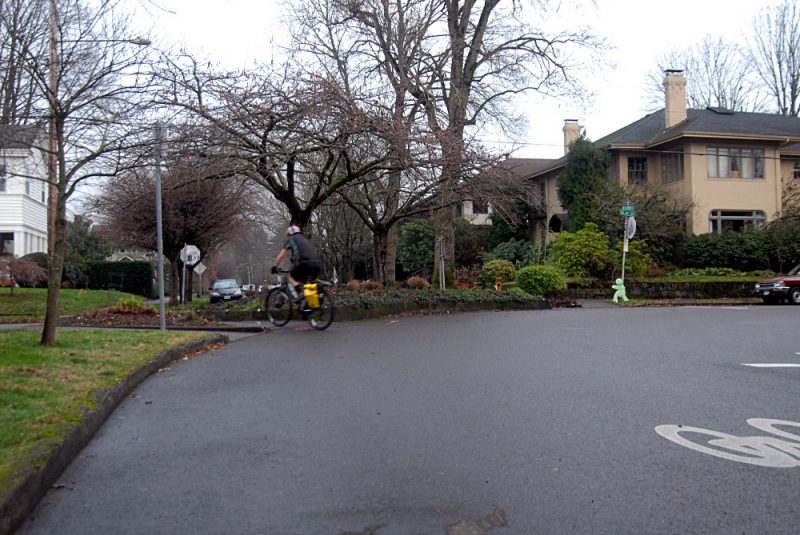(Jonathan Maus contributed reporting to this story.)
After more than a year of focused activism that included guerrilla installations, a month-long celebration and numerous rush-hour rides, one of Portland’s highest-traffic neighborhood greenways has been chosen as the site of a traffic calming pilot project.
The announcement is a significant victory for BikeLoudPDX, an upstart group that has focused much of its activism around its perception that Clinton Street has become too thick with fast-moving motor traffic.
In an email to BikePortland last week, city spokesman Dylan Rivera said the city has chosen Clinton Street as the site for a project that “may involve some diverters, speed bumps and signage.”
The announcement comes after an internal city study found that inner Clinton has some of the higher auto traffic volumes and speeds in the neighborhood greenway system. In June, after a series of dramatic bike-related collisions led to an emergency summit with safety groups, a new program to install temporary, experimental diverters was the single most substantive promise announced by Mayor Charlie Hales.
The changes to Clinton would take effect just before the Tilikum Crossing bridge opens on September 12. The new bridge will further boost the importance of inner Clinton as a bike route.
Diverters are already used on many neighborhood greenways to allow foot and bike traffic while blocking car traffic at certain intersections, preventing it from being useful to non-local car traffic.
Some people argue that diverters tend to reduce car speeds as well as traffic volumes, though there’s no established evidence about their effect on speed.
Rivera said in his Thursday email that the city has tasked Rich Newlands to be the Clinton Street project manager, “but the internal project team needs to do more work before we have a proposed design. We intend to involve the public in finalizing the plan before implementing a pilot project on Clinton Street this summer.”
The announcement is a significant victory for BikeLoudPDX, an upstart group that has focused much of its activism around its perception that Clinton Street has become too thick with fast-moving motor traffic in the last few years. Some people say this is preventing the street from serving as the all-ages bikeway it’s supposed to be.
Advertisement
Even before BikeLoudPDX began to focus on the issue, locals starting a monthly social ride that aimed to, “raise awareness that Clinton is a Bike Blvd [sic] and not a cut through for rush hour traffic.”
It’s not yet clear whether the city is considering diverters at more than one intersection.
“Personally I think we need two: I would look at putting a diverter at SE 21st, or possibly 20th, to help protect the inner-most part of Clinton from cut-through traffic from Powell trying to avoid the traffic/train issues closer in,” wrote Christopher Eykamp a board member of the Hosford-Abernethy Neighborhood District Association. “A second one should be put at either 26th, or possibly a bit higher up, to make the section from 39th to 26th less attractive for driving.”
The Bicycle Transportation Alliance joined BikeLoud in calling for diverters. So did the adjoining Hosford-Abernethy Neighborhood District Association, specifying that they should be part of an experiment to divert traffic onto Division rather than other neighborhood streets. Last month, Richmond neighborhood residents turned out in unusually high numbers and elected at least two new pro-diverter candidates to their neighborhood assocation, too.
“After the results of the neighborhood greenways report become public in August, that could lead us to look at some other pilot projects involving diverters or other engineering tools.”
— Dylan Rivera, PBOT
Calls like these found receptive ears within city government, prompting Active Transportation Division Manager Margi Bradway to order a major study of the city’s neighborhood greenway system. Hales cited that study in his announcement of the forthcoming diverter program.
So did Rivera, in last week’s email.
“After the results of the neighborhood greenways report become public in August, that could lead us to look at some other pilot projects involving diverters or other engineering tools,” Rivera said.
A year ago, in an interview about the future of neighborhood greenways, PBOT staffer Greg Raisman told us that the city must weigh improvements to Clinton against biking improvements elsewhere in the city, and said that in the absence of political will and widespread consensus over diverters on Clinton, there wasn’t enough money to prioritize improvements there.
Now, thanks in large part to the concerted advocacy efforts, the will — and the money — appears to have been found.
CORRECTION, 3:54pm: The original headline of this story said the City “confirmed” diverters would be coming to Clinton. To be clear, the City said the project “may involve some diverters.” The ultimate outcome is still up in the air pending a planning process. Sorry for any confusion — Jonathan




